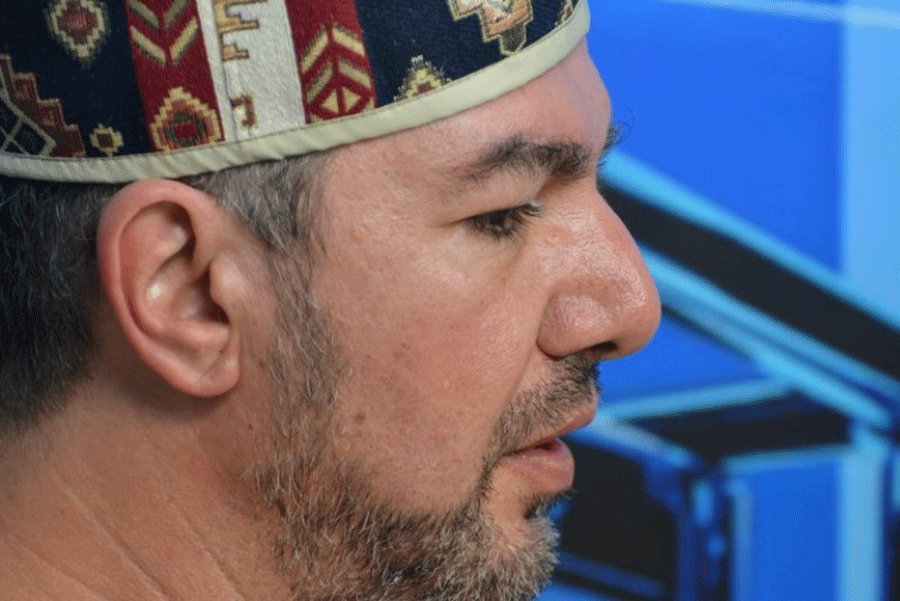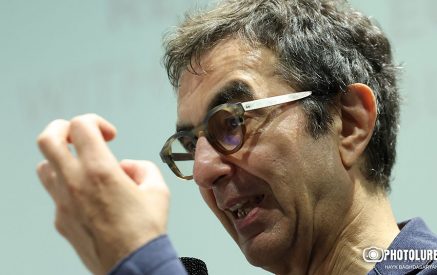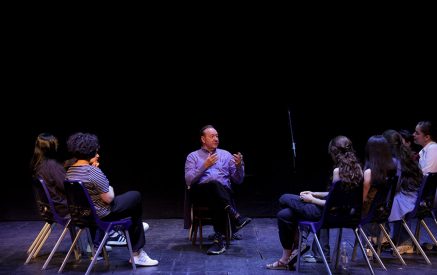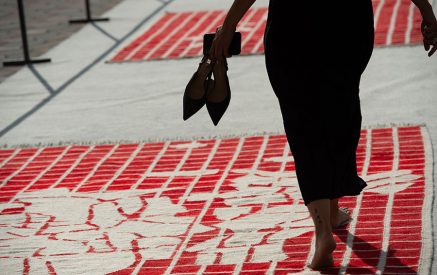by Artsvi Bakhchinyan
YEREVAN/BUCHAREST — Theater and film actor, director, casting director, PhD lecturer, writer Florin Kevorkian was born in 1970 in Bucharest. He studied acting at Caragiale National University of Theatre and Film, where he is a lecturer now. In 1999, Kevorkian graduated from the High School of the University of Theater and Cinema in Bucharest, specializing in film directing and script writing. He is a casting director of about 20 films, actor in more than 15 and director of seven films. His acting credits include “The Shrunken City,” “Train of Life” (1998), “Amen” (2002), “The Wind of Change” (2013), “Pioneers’ Palace” (2015), “Hotel of the Damned” (2016), “A Study on Anxiety” (2016), “Lilith” (2019), “Adrenaline” (2022), etc. Florin Kevorkian has also published a novel (“My Love… Izabela”) and articles on theater.
Dear Florin, how did it happen that you went from being an actor to a casting director?
Read also
For me, this transition from actor to casting director happened in 1999 when I was invited by Mrs. Irina Charita — one of the great film directors and executive producer of two of the biggest film studios in the country, Castel Film and Media Pro Pictures — to be part of a new department organized in Buftea for the development of national and international cinematographic projects. The meeting with her was in the film “Train of Life” by Radu Mihaileanu, the film in which I debuted, along with many other casting directors from Romania, as assistant director, extra coordinator. It should be noted that in that film a new team of cinema makers was born in all fields of film production and direction: Tudor Giurgiu (well-known director, at the moment and director of two major film festivals, TIFF and GOPO), his casting assistant was Catalin Dordea (the current casting director of Cristian Mungiu’s films — one of the most successful directors in Romania and Europe), Cristian Mungiu (who was then assistant director), Marian Pascale (at that time, the producer’s driver, and now one of the biggest film producers in Romania). We were a young team and full of the desire to assert ourselves in a professional way and at a high level of cinematic culture. We were all in love with cinema and fervent art followers of the Romanian Cinematheque. We have all remained friends and good colleagues and have reunited on countless projects over the years, from then until now.
The next step was when, after two other training films, as a casting director, I dove in with an award-winning and world-acclaimed director, Costa Gavras, who won an Oscar for the film “Z.” On the film “Amen,” I went into the fire in an international casting with 125 characters of which 77 were Romanian actors, therefore, if we put a minimum of four proposals for each role, in my mind there were, at that moment, a number of 300 Romanian actors of all ages and bills. It was not for nothing that I had nightmares, with images of the Romanian actors who played in this film and in another 30 films for which I did the casting.
Then, I was lucky enough, also as a casting director, to work with Francis Ford Coppola, on the film “Youth Without Youth,” where I met again a wide variety of Romanian and European actors, including: Tim Roth, Bruno Ganz, Alexandra Maria Lara, Adrian Pintea, Dorina Lazar, Ana Maria Marinca. It was a joy to meet with “Lord of the Rings” make-up artist Jeremy Woodhead, along with Anahid Nazarian, the film’s script supervisor and executive producer.
If I would list all the European actors and all the personalities I met, I would answer only one question and I don’t want to leave out the others. The transition from actor to casting director is done naturally, out of love for actors and to give them what I would have liked to receive in the castings that I joined: attention, patience in searching and discovering the character, small defining details for the sequence at work, the patience to find the best double, the organization of the shooting space, objects for the actor, costumes, set and even the interpretation of the other character to look for the emotion. The casting action is not only “Choose, brother, you find the actor quickly, put the contract, that the project must go and that’s it!” Casting is, as Billy Wilder used to say, 85% of the value of a film.
I remember your film “Birth” in the first Golden Apricot in 2004, where the prosaic, “bloody” process of human birth later turned into something poetic. Already in 1929 Dziga Vertov in his famous “Man with a Movie Camera” had filmed the human birth. So why film this very intimate (although mystical!) scene again and agains?
For my film “Birth” I almost failed the directing exam, as my film teachers considered the detailed filming of the operated and bloody uterus, as well as the child whose umbilical cord is cut and is drawing its first breath. They appreciated me again when I reminded them that on my video camera I was seeing it in black and white, so I was deprived of the bloody image, the throbbing of life and the specter of death. The fact that the great Dziga Vertov chose between the moments of life, filmed for the first documentaries of the cinematographic world, and this essential moment in the evolution of the world — the birth of a new child — only proves to us one more time what are the essential points that any man unfolds the thread of his life: birth, deep love and marriage, the birth of the new being and death or the great crossing towards “that border beyond which no traveler has returned.”
You have done five documentaries on Armenian subjects. Could you please present them to our readers?
The first film with an Armenian subject is “Armenopolis, Armenian Soul,” dealing with the population of the central area of Transylvania with a group of Armenian refugees in the face of the vicissitudes of history in the 17th century, when the ruler, Duca Voda, of Moldavia, expels, through legislative pressure and threats, almost 13,000 of people — men, women, elderly, children of Armenian origin — and forces them to move to Transylvania, where they spread in important communities: Armenopolis, Somesujvar, Gherla, Elisabetapolis, Dumbraveni, Frumoasa and Gheorgheni.
“Hagigadar” is about the monastery built five centuries ago on a hill near Suceava, by the Donavac brothers. Hagiui Gadar means “fulfilment of wishes” in Armenian and is the place where people, for five centuries, climb the monastery hill on their knees, praying to the Mother of God for support in the hardest moments of life: illness, death, poverty, separation, broken loves, broken hearts, shaky health… Many times, those who prayed to the sacred icon regained their strength to hope and dream and then they returned in the same way to the monastery and thanked the Saint Virgin Mary and to Our God for the fulfillment of fervent desires.
“Noravank,” a film produced and directed in Armenia, with the best cinematographer of Echmiadzin, about the love story between a great teacher, architect, Momik Vardapet and the daughter of King Orbelian, who was only 17 years old. From this passion, imagination and science of the teacher, the Noravank monastery was born, one of the most beautiful monasteries in Armenia and in the whole world. Through the sacrifice of Momik Vardapet, at the completion of this monastery, the root of another great legend is born, the legend of the craftsman Manole.
“Recognize 1915,” filmed at the Genocide Museum in Yerevan, is a tribute to a historical gesture, which made more than 1,500,000 Armenians disappear, in the futile attempt of the Turkish juries to revive the economy of an empire adrift.
“Bukovina, the land of beech people, the land of true love” is a film about the real power of living together of 12 different cultures and faiths — Jews, Armenians, Italians, Greeks, Russians, Lipovians, Ukrainians, Ruthenians, Hutus, Hungarians, Germans, Gypsies and Romanians — who for over 300 years, since the time of Empress Maria Teresa, have managed to live organically together, having a common binder: the grandmother of the family. The grandmother is the one who has the necessary wisdom, after a lifetime, to know the meaning of gentleness, love, tenderness, the importance of embracing, as well as the unity between people, in difficult moments of life, regardless of history, religion, culture, language, all different.
What else you do aside from films?
First of all, I love my wife more than anyone in the world and I thank God every day for giving me the joy of having such a beautiful soul by my side now. And in this joy are included all the other activities of my life: acting in the play “Face to Face” by Peter Quilter, where I have four different roles, together with my wife, in four life moments that talk about the union between people through love; “A Midsummer Night’s Dream” by William Shakespeare, where I am the master-donkey, literally and figuratively, Bottom; other performances, “Easter Mystery,” based on the biblical books, “Nameless Star” by Mihail Sebastian, “Matraguna” by Machiavelli; we are also opening a social school of communication through art, “Aristotle” — dance, speech, singing, bodily expressiveness, acting — through which people can learn again, after the pandemic period, to reach out, hug, communicate.
The surname Kevorkian is famous in the US because of “Dr. Death” Jack Kevorkian. How is it having a famous name?
My name in Romania is assimilated a little with the name of a well-known man in the world of football, Chevorchian, and only for those who have relations with foreign countries, I tell them that I have a distant relative and if they are not fair in business, I tell them about him. Of course, I’m joking. But, I admit, that the sick world in which we live motivates Dr. Kevorkian, through public mercy, to eliminate those people who have nothing but to suffer. I have often felt that all the debts that are placed on my shoulders, from the administration and the banks, are like a wound that hangs on our souls and minds, it is a disease from which we cannot be cured, and not infrequently I have felt, in front of the banks, to apply Dr. Kevorkian’s methods. Death and Taxes follow us beyond the laws of nature, taking the joy out of our stomachs, out of our blood, out of everything…
Speaking of names, I am also called, especially among Armenians, the Actor of Death, the Director of Death, or the Artist of Death in general. It is our dear, Armenian humor, without which we would not have been able to go through such difficult moments of the two genocides — from 1894 and from 1915 — we would not have gone over dead separations and continuous pain… We are, part of a strong people and KEVORKIAN is one of the Armenian families, always predestined to find themselves between life and death…
What is the history of your family? And how do you transfer your Armenian heritage to your children?
The history of the Kevorkian family begins in Adana, where they raised and sold pigs and cattle. There are family histories dating back to the 19th century, about a great-grandfather who so closely resembled Franz Josef that he was the only one to be received with his animals at the imperial court in Budapest during a swine fever that blocked trade with animals all over Europe. During the first genocide, 1894-1896, the family left Adana for Lvov, Poland, where they stayed for a decade and where my grandmother, maiden name Moiszesowitch, married grandfather Kevorkian and they crossed over to Armenia around 1914-1915. On the way to Armenia, they stopped in Bessarabia, in the city of Balti. The horror of the First Genocide of the 20th century, against Armenia, stopped them in Balti until the 40s, when during the Second World War, Bessarabia was taken over by Russia and its inhabitants were threatened with deportation to Siberia. Then my family, Kevorkian-Moiszesowitch, left for Transylvania, for Alba Iulia and from there they went down to Bucharest, where my father and uncle were sent to study at high schools. Dad graduated from the Faculty of Romanian Language and Literature, as well as the Faculty of Foreign Languages. Until the end of his life he learned five foreign languages: French, Russian, Bulgarian, Polish, Czech, becoming one of the few specialists of the National Tourism Office in Romania. My uncle, Anton Chevorchian, graduated at the highest level from the Faculty of Romanian Language and Literature, and became one of the greatest teachers of his time, recognized by the large number of students who passed through his classes and graduated from important faculties throughout the country and abroad. I am also part of a family where all my uncles and aunts on my mother’s and father’s sides are teachers, which is why, although I was against it, my path as a teacher was part of my DNA.
My children, present and future, have learned and will learn that they are free people of this land, wherever we live they respect their name of Armenians, religion, education and culture of this beautiful and special nation of this world. Wherever my children live, they are taught to choose to do the job they want in life and try to be the best in their field. My children learn to love clear skies and fresh land, mountains and waters, literature and poetry, sweets and books, music concerts and Italian ice cream, baklava and good movies… to generally love what pleases people and brings joy to live, in a world where hatred, misunderstanding, suspicion, accusation, lack of generosity, deepening in the darkness, in the special administrative arrangement, correct for the state and not for the individual, teaches people to sink into social correctness, cold and without a soul, by which we learn that it is better to pay the rent than to buy a chocolate, it is better to pay the bank than to buy a flower, so, my children will learn to live free.
God gave us a paradise on earth, very resistant, which we have been trying to kill for thousands of years, by providing it with strict laws for operation, organization, administration, taxation — punitive laws — which become much more important than cosmic laws, than divine laws, than natural laws. It seems to me a violation of social laws to enjoy, to love, to hold hands, to kiss, seriousness dries up, directing false relationships, this “it is inappropriate” stops the shine of natural human relationships and gives value to the psychological prison in which we are allowed to live through the primary education we receive. We have forgotten the simple, human joy that comes from the soul, body and mind, beyond the existence of restrictive financial forms imposed by the states where we live… the joy of a kiss, the joy of a hug, the joy of touching the hand of a person who loves you, the joy of movement, the joy of dancing, we learned to buy our joys. I fight with my children together with my wife, Denisa, to continuously re-teach them that the true beauty is that of nature, of a pure soul, of a clear thought, of the divinity that exists in every moment, the joy of loving like a breath, to feel that life means the bright passage through love from one breath to another. Finally, I can say, my children know that any country in the world can be their country, for the simple fact that their true country was, is and will be for always, Armenia.
Florin, do you have any Armenian-related project in near future?
Of course, I have theater, film, screenplay writing projects, and by the simple fact that I am Armenian, these projects have no way for me to come out, without my Armenian soul leaving its mark on them, without the education and culture my oriental love does not leave its mark on them, without love, deep human love not showing through the fiber in these projects. I am in love as any man on this earth should be and I thank God for giving me the woman I have been waiting for a lifetime and then all my projects are started from love and are about love. I have two Armenian pieces by Karine Khodikyan, that talk about the modern period of Armenia.
The second project is about Apafi and Anne, and it covers the historical period in which 13,000 Armenians crossed from Moldova to Transylvania, it is somehow, if we want, a prequel to the film “Armenopolis — Armenian soul.” In this film we talk about the love between Count Apafi and Anne de Bornemisa, about the importance of having a family, about her lifelong struggle to have a living child.
Another project is “Stephen,” about the great ruler who also encouraged the existence of Armenians in the Moldavian fairs of his time. And even if it is not the main topic, I will not pass it without correlating the existence of Armenians during the time of Stephen’s Moldavia.
There is also a project about the culture of Byzantine music and psalms, in which, again, I will evoke the foundation of religious music as part of the founding period of the Armenian Apostolic Church.
So, I can say that directly or indirectly, deeply or tangentially, whether I am talking about theater, film or pedagogical and educational projects, my Armenian origin will always be like a basic structure in everything I do, in everything I create, in everything I breathe and love.



























































